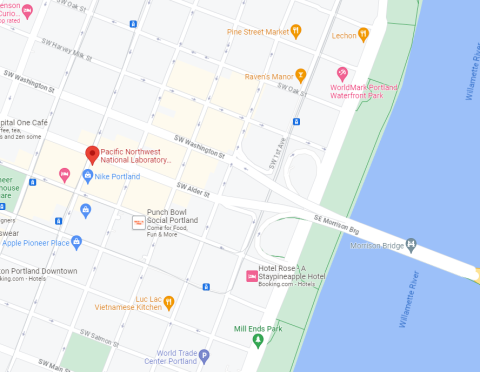Portland Research Center
Portland Research Center

The PNNL Portland Research Center was established to advance the missions of the laboratory and more specifically the work being performed by the lab’s Energy & Environment Directorate by:
- Facilitating collaboration and strengthening partnerships with the many Portland-based organizations working on energy efficiency and renewable energy
- Providing access to talent in the Portland ecosystem that we couldn’t otherwise attract and/or retain
The staff currently working out of PNNL’s Portland office primarily focus on:
- Building systems research, analysis and operation for energy efficiency
- Distributed energy resource integration for resilience and decarbonization (transmission and distribution scales)
- Clean energy policy including building energy codes equipment standards
Getting to the Portland Office
The PNNL Portland Research Center is located at:
620 SW 5th Ave, Suite 810
Portland, OR 97204

Driving Directions
From the airport/points east and points north:
- From the airport/points east: Take I-84 West to exit I-5 South towards Salem. (I-84 splits where it meets I-5, so you’ll need to stay in the left lanes.)
- From points north: Take I-5 south
- Take the Milwaukie/City Center exit
- Keep right at the fork in the ramp, taking the lane marked City Center.
- Turn right onto Morrison Bridge.
- Take the ramp for Washington Street.
- Turn left onto 3rd Avenue
- Proceed one block to the Smart Park garage on your right.
- From the parking garage, walk one block west (away from the river) to 5th Avenue.
From points south:
- Take I-5 North to exit 299-B/I-405 exit toward City Center/USE26/Beaverton
- Take exit 1A toward Naito Parkway/National Historic District.
- Stay straight to go onto SW Harbor Drive
- Turn right onto SW Front Avenue/SW Naito Parkway/OR 99W N.
- Turn left onto SW Taylor St.
- Turn right onto SW 4th Avenue.
- Proceed two blocks to the Smart Park garage on your right.
- From the parking garage, walk one block west (away from the river) to 5th Avenue.
Public Transportation
The Portland MAX Light Rail runs every 15 minutes and stops just 1/2 block from the Portland Office.
View the MAX Light Rail system map and schedules
Contact
620 SW 5th Ave, Suite 810
Portland, OR 97204
Phone: (503) 417-2174
Fax: (503) 417-2175
Jian Zhang
Research Line Manager
[email protected]
Anne Manning
Senior Administrative Coordinator
[email protected]